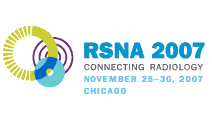
Abstract Archives of the RSNA, 2007
SSM19-04
Profit-based Two-dimensional 1H MR Spectroscopic Quantitation of Metabolites in Healthy Human Brain Using 3T and 1.5T MRI Scanners
Scientific Papers
Presented on November 28, 2007
Presented as part of SSM19: Physics (MRI and MRIS—Novel Methods)
Michael Albert Thomas PhD, Presenter: Nothing to Disclose
Enrique Frias-Martinez PhD, Abstract Co-Author: Nothing to Disclose
Sherry Liu MS, Abstract Co-Author: Nothing to Disclose
Nagarajan Rajakumar PhD, Abstract Co-Author: Nothing to Disclose
Aparna Singhal MBBS, Abstract Co-Author: Nothing to Disclose
Shida Banakar PhD, Abstract Co-Author: Nothing to Disclose
Saadallah Ramadan PhD, Abstract Co-Author: Nothing to Disclose
Anand Kumar MD, Abstract Co-Author: Nothing to Disclose
Anke Henning BS, Abstract Co-Author: Nothing to Disclose
Rolf Schulte PhD, Abstract Co-Author: Nothing to Disclose
Peter Boesiger PhD, Abstract Co-Author: Nothing to Disclose
et al, Abstract Co-Author: Nothing to Disclose
et al, Abstract Co-Author: Nothing to Disclose
A major goal of this pilot project was to evaluate the reliability of a two-dimensional (2D) prior-knowledge fitting of J-resolved spectra in healthy human brain and phantom solutions using the 3T and 1.5T MRI scanners, and to compare the performance with one-dimensional (1D) PRESS spectra processed using LC-Model.
A 2D J-resolved Spectroscopic sequence (JPRESS) was implemented on the 3T and 1.5T MRI scanners after compiling with a Siemens VB13 Idea compiler. Following parameters were used in ten healthy volunteers: TR/TE=2.5s/30ms, 2.5x2.5x2.5 cm3 voxel, 4averages per Δt1 and 100 Δt1 increments. A white matter brain phantom containing more than sixteen metabolites at physiological concentrations (pH=7.3) was used for the in vitro measurements. The Profit algorithm was installed in MATLAB (version 7, R14) running on a PC equipped with Windows XP and a 2.8GHz processor. 1D PRESS spectra acquired using the same voxel size and location, TR/TE and 256 averages were processed using the LC-Model algorithm.
2D Profit analysis of the 3T JPRESS spectra recorded in the occipital gray/white matter enabled quantitation of several metabolite ratios (mean): (1.6, 0.12, 0.19, 1.01, 1.25, 0.42, 0.55, 0.26 and 0.33) for N-acetyl aspartate, N-acetyl aspartylglutamate, (phosphocholine + glyceryl phosphocholine), myo-inositol, glutamate, glutamine, aspartate, glutathione and GABA with Cramer-Rao lower bounds (CRLB) below 20%. Due to the limited spectral resolution, the Profit analysis of 1.5T JPRESS spectra had higher CRLBs for weaker metabolites such as aspartate, phosphoethanolamine, glutathione and GABA, and inconsistent ratios of metabolite resonances which are close to water. These ratios from the 1D LC-Model analysis of PRESS spectra were (1.37, 0.07, 0.14, 0.75, 1.32, 0.1, 0.55, 0.0 and 0.21).
The preliminary findings of this pilot project using 2D prior knowledge fitting of 3T JPRESS spectra show more reliable assessment of 12-15 cerebral metabolite ratios than that recorded using the 1.5T MR scanner MRI scanner.
In addition to resolving several metabolite resonances unambiguously using 2D JPRESS, absolute quantitation was facilitated using prior knowledge fitting.
Thomas, M,
Frias-Martinez, E,
Liu, S,
Rajakumar, N,
Singhal, A,
Banakar, S,
Ramadan, S,
Kumar, A,
Henning, A,
Schulte, R,
Boesiger, P,
et al, ,
et al, ,
Profit-based Two-dimensional 1H MR Spectroscopic Quantitation of Metabolites in Healthy Human Brain Using 3T and 1.5T MRI Scanners. Radiological Society of North America 2007 Scientific Assembly and Annual Meeting, November 25 - November 30, 2007 ,Chicago IL.
http://archive.rsna.org/2007/5014241.html

